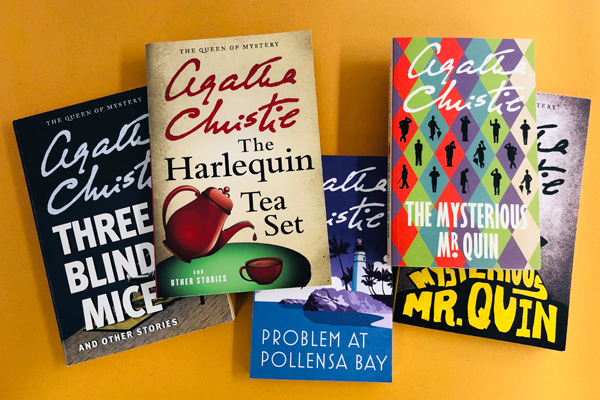Features
The Other Detectives: Quin and Satterthwaite

This piece was researched and written by Catherine Brobeck and Kemper Donovan, co-hosts of the All About Agatha podcast.
From Kemper: When Catherine and I wrote this piece, we were three years into our madcap project to read, and rank, all 66 of Agatha Christie’s mystery novels. Tragically, just two years later, Catherine would pass away unexpectedly—which makes the opening quotation of this article, and the article itself, that much more poignant. Thanks to the generosity of fellow Christie obsessives—friends like Caroline Crampton, host of the Shedunnit podcast, and Christie scholars Tony Medawar and Jamie Bernthal-Hooker—I managed to complete this project in Catherine’s absence, and very much in her honor. I encourage you to look us up (you can search for “All About Agatha" wherever you listen to podcasts), and to spend a little time in this odd space of the Christie-verse that Catherine and I carved out for ourselves. It’s a space not unlike the odd corner of the Christie-verse where Mr. Quin and Mr. Satterthwaite live: a place where Catherine lives on, urging us to “never underestimate the help,” and forever fine-tuning her “dark Marple” theory as to the more sinister aspects of St. Mary Mead’s resident sleuth…. I’ve also continued to put out new episodes, because where Christie is concerned there is always something new under the sun—evil, or otherwise.
It is life that matters. We do not want someone young, someone who is happy, or could be happy, to die. … That is the reason why we must always save a life when the command comes.
So says Mr Harley Quin to his friend Mr Satterthwaite in Agatha Christie's final short story featuring the pair, 'The Harlequin Tea Set' (1971) — the last short story she ever wrote, forty-seven years after the characters' first appearance in 1924.
At first glance, the fourteen stories that feature this duo (twelve collected in 1930 in The Mysterious Mr. Quin, the other two appearing in various collections) seem like outliers, oddities. The supernatural hovers at the edges of these tales much like Mr. Quin himself, a mysterious figure who functions as a catalyst of sorts, an inspiration to the lonely yet well-connected Mr Satterthwaite. Appearing dramatically in each story, the otherworldly Quin urges his friend to draw on his powers of observation and memory to untangle the intrigue du jour — usually with very little in the way of clues or deductive reasoning compared to Christie’s more traditional mysteries.
First glances, however, can be deceiving.
Having recently completed a review of The Mysterious Mr. Quin for our Christie-centric (read: Christie-obsessed) podcast, All About Agatha, we were struck by the similarities between that “little bent, dried up man” Mr Satterthwaite and perhaps the most central figure within the Christie canon: Hercule Poirot himself. Like Poirot, Mr Satterthwaite is an observer; he sees and hears things others don’t. More significantly, he is an aesthete, his predilection for beauty matching that of Poirot’s for order. (And Christie certainly has fun indulging her personal fondness for art and music by way of Satterthwaite’s highbrow taste.) The same attentiveness to environment that allows Poirot to notice when a vase is askew on a mantelpiece (The Mysterious Affair at Styles, bien sûr) is what allows Satterthwaite to conclude that a rug was placed in the wrong room, after noting that rug’s absence in an artist’s rendering of the space ('The Dead Harlequin'). Like Poirot, Satterthwaite is single and childless, despite obvious leanings toward romanticism and sentimentality. Both men fall effortlessly into the role of priest/confessor, lending a fine-tuned yet sympathetic ear—especially when it’s thwarted young lovers who are doing the talking.
As in the Poirot novels, the ultimate goal is not to enact vengeance on the guilty, but to allow the innocent to live freely, uninhibited by the anxieties that come from a lingering unsolved mystery. We often lose sight of this goal in Christie’s more traditional puzzles, where whodunit tends to overwhelm our attention, but not so in these stories, where themes of grief, despair, lost love, and family turmoil appear unadorned. Often these stories are situated at a critical juncture in a person’s life: the discovery of an extramarital affair ('The Shadow on the Glass'); a woman gambling with her last franc ('The Soul of the Croupier'); an ardent suitor whose affections have been rejected ('The Face of Helen').
In the standout story of the collection, 'The Man from the Sea,' the worldly Mr Satterthwaite goes on holiday to an island identified in a subsequent story as Corsica (really, it’s Tenerife, the island Christie visited in early 1927). At the top of a scenic cliff sits a man who has suffered from illness, lost love, ageing, and loneliness. So... a lot. Our observant Satterthwaite intuits that he is contemplating a plunge into the sea below, and thwarts the attempt. The story ends with Mr Quin strolling off that same cliff: our first concrete clue that he may not be exactly mortal. More intriguingly? This same exact scenario—down to the descriptions of the cliffside bench, the despairing visitor reeling from lost love, and the act of intercession by another lonely traveler—is all used in the setup to the semi-autobiographical (and deeply personal) novel Unfinished Portrait, which Christie would write in 1934 under the pseudonym Mary Westmacott.

There is one major way in which Poirot and Satterthwaite function differently. Littered throughout these stories is a consistent lament from Mr Satterthwaite about having always been an audience to life, never an actor. He routinely feels unable to solve the problems placed before him, until Mr Quin notes that he has seen much of life and is in fact the perfect person to solve whatever needs solving. Prodded, Mr Satterthwaite instinctively does just that.
Poirot would never speak this way; he is too aware of his abilities when it comes to logic and reason — his invaluable little grey cells! — powers so enormous they’re practically supernatural, a deus ex machina that gets us to the glorious end of every single novel in which he appears. In The Mysterious Mr. Quin, the deus ex machina is of course Mr Quin himself, sans machina. In the final story of the collection, 'Harlequin’s Lane,' Christie hints strongly (by way of a sly reference to Oscar Wilde’s story The Happy Prince) that Mr Quin is at the very least a divine emissary. But an equally valid reading is that Mr Quin is simply that which Mr Satterthwaite draws on in moments of crisis, the “lean, strong, well-muscled” counterpart to his shrunken, wizened frame (Brad Pitt’s Tyler Durden to Edward Norton’s unnamed narrator, if a Fight Club reference works for you). After all, Mr Quin shares the same highbrow taste in the arts and even enjoys the same fine dining establishments (Arlecchino is apparently to die for). In this way, they function as two halves of the perfect detective: the human who, despite appearances, cares deeply for those around him, and the superhuman who backs up that compassion with the audacity necessary to pull off an extraordinary resolution. Both are vital; neither could exist without the other.
Perhaps the real magic of these stories, then, is the way they inform our reading of the larger Christie oeuvre, while providing greater insight into the mysterious author herself. Not that we can’t enjoy them in and of themselves! After all, Christie identified them as her favourite, writing them only when she wanted to, on her own terms. In so doing, she created a uniquely insightful corner of the Christie-verse well worth the visit.
About the authors

Catherine Brobeck and Kemper Donovan are the co-creators and co-hosts of All About Agatha, a free-to-download podcast dedicated to Agatha Christie. Subscribe wherever you listen to podcasts. You can find the podcast on Twitter and Instagram, and you can find Kemper on Facebook.
Catherine attended Yale University where she received her B.A. in Comparative Literature with honors for a thesis about social realist narratives as they involve crime and geography in the 1930s Los Angeles novel. She subsequently wrote about art, the food industry, and women’s health and wellness. Tragically, Catherine passed away at the end of 2021. She will be forever missed by the many friends and family members she left behind.
Kemper attended Stanford University where he received his B.A. in English literature with honors for a thesis about Wilkie Collins and the nature of adaptation. He subsequently attended Harvard Law School. His first novel, The Decent Proposal, was published by HarperCollins in the US in 2016. His first mystery novel, The Busy Body, will be published by Kensington Books in 2024.


 UK
UK 